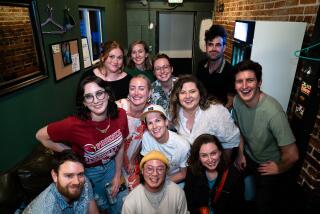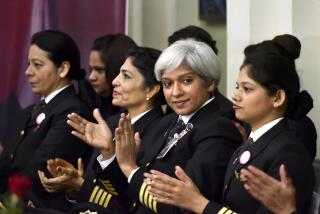An Update on Flight Attendants : Many Changes in the Job and Those Who Perform It
- Share via
If you’re old enough to order a drink on an airplane, you’ve probably noticed some changes.
The planes are faster, wider and longer. They carry more passengers. But there’s something else: a new breed of flight attendants.
Today’s flight attendants may be male or female and range in age anywhere from their late teens to their 60s. They come in all shapes, weights and sizes (as long as it’s “in proportion”), from virtually every background and geographical location.
One airline has lawyers and dentists moonlighting as flight attendants. Another’s attendants commute to their U.S.-based jobs from Chile, Italy, even Bali.
‘Beautiful Bubbleheads’
Yesterday’s “stewardesses” and “stewards” tended to look alike: young, cute (or handsome), immaculately coiffed, poised and all smiles. In the earliest days of commercial aviation, they were called “air hostesses,” but behind their backs it was “glorified waitresses,” and more disparaging, “beautiful bubbleheads.”
At TWA 50 years ago, the job was limited to women. Of the 2,000 original applicants, the airline hired and trained two dozen, and started them at $100 per month.
Early hostesses were white, female, single, younger than 26 and stood 5-feet-4 or less. They also were registered nurses (to enhance passengers’ peace of mind). They were required to inspect and clean lavatories, sweep the cabin floor and dust the windowsills before each flight, control the craft’s heating system, distribute cold box lunches as well as cigarettes and chewing gum, take care of baby passengers, point out places of interest below and, when out of uniform, chew a pack of gum a day to ward off double chins.
Today’s flight attendants have other, more demanding duties. They’re screened for psychological and diplomatic balance, and are rigorously trained to deal with potentially catastrophic situations, anything from air accidents to terrorist incidents to helping deliver babies, six miles up.
There may be as many as 30 applicants for each vacancy, and it isn’t unusual for 10% of those accepted to drop out before completing training.
Uli Derickson, senior flight attendant aboard TWA’s Flight 847, hijacked in June, 1985, for example, was credited with saving the life of at least one of her craft’s American passengers, and intervening on behalf of many others. She also used her personal credit card to charge $11,000 worth of fuel after officials at Algiers Airport refused to refuel the plane because TWA didn’t have an account there.
Where flight attendants averaged 18 months to two years’ service in the 1960s, today’s average service is about 12 years.
‘Marriage, Age Limits’
“The real change, in terms of people making a commitment to careers as flight attendants, came with the turmoil caused by lawsuits in the late ‘60s, and action by the courts and Congress to remove discriminatory rules concerning marriage and age limits,” says Joe Madison, research director of the Transport Workers Union.
Training programs in the past centered on grooming, poise, customer service. Today’s programs focus more on safety and customer comfort, says Jane McDonnell, a former flight attendant and now one of United Airlines’ in-flight management executives.
“Appearance was stressed in the old days, but now we focus our training on interaction with the customer, safety, customer assistance and operation of the cabin equipment.”
Flight attendants must, for example, be able to evacuate all passengers from an aircraft in 90 seconds or less. They are responsible for the entire aircraft, except the flight deck. They are trained to identify and handle medical emergencies, fight fires, operate the galley equipment and electrical system.
More people are choosing the field as a career, and others are using it as a jumping-off point for corporate advancement. An attendant willing to work a maximum amount of overtime can sometimes earn more than $40,000.
“The rules are gone, the pay is up, and a lot of couples are facing the need for two salaries,” says United’s McDonnell.
Robert Wessler, a 34-year-old New York-based attendant with Pan Am, says he was drawn into the field because of the travel opportunities, along with the flexible work schedules.
Flight attendants bid for flight routes, which then are awarded on a seniority basis. They also are allowed to trade trips with others, giving them even more flexibility.
As with the dentist and lawyer flight attendants, they can use their free time to develop businesses of their own. Several attendants are in the export-import business and use their time between flights to develop contacts.
Becky Ehmann, 45, the mother of girls 24 and 21, didn’t even know she was applying for a job as a flight attendant when she answered a People Express advertisement for “customer-service managers.”
“When I got to the initial interview and discovered that was part of the job, I thought, ‘Gee, wouldn’t it be fun?’ ”
‘Involved With People’
Adam Kenaio, 35, worked as an auto mechanic, airframe and power-plant mechanic before “I got tired of the grease and decided I wanted to be more involved with people.”
He earned his real estate license and, after an unsuccessful stint in that field, finally got a job as a flight attendant. “I really like the work, because you get to meet so many interesting people, both the other attendants and the passengers. I also like the changing routine. Maybe I’m a gypsy or something.”
If today’s attendants don’t seem as attentive as in the past, one reason might be that they don’t have time. In the good old days, the 14-passenger DC-2 carried one hostess, who had plenty of time to deal with just a few passengers. Today’s 747s can carry more than 400 passengers, with only 12 or 13 attendants--a ratio of one attendant for 30 or more passengers.
More to Read
Sign up for The Wild
We’ll help you find the best places to hike, bike and run, as well as the perfect silent spots for meditation and yoga.
You may occasionally receive promotional content from the Los Angeles Times.






